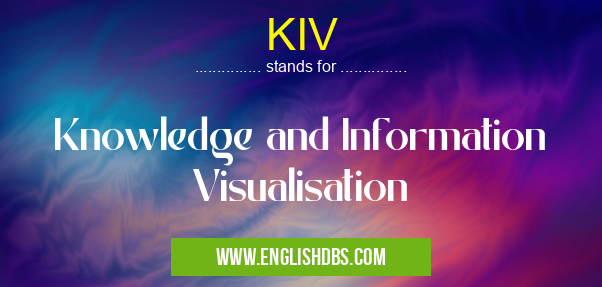What does KIV mean in UNCLASSIFIED
KIV stands for Knowledge and Information Visualisation, a technological field that deals with the visual presentation of data and information. It aims to enhance the accessibility, comprehensibility, and impact of complex knowledge and data by transforming it into visual representations, such as graphs, charts, and interactive dashboards.

KIV meaning in Unclassified in Miscellaneous
KIV mostly used in an acronym Unclassified in Category Miscellaneous that means Knowledge and Information Visualisation
Shorthand: KIV,
Full Form: Knowledge and Information Visualisation
For more information of "Knowledge and Information Visualisation", see the section below.
What does KIV Involve?
KIV encompasses various techniques and tools to:
- Data Collection and Preparation: Gathering relevant data from different sources and preparing it for visualization.
- Visual Encoding: Converting data into visual elements, such as colors, shapes, and positions, to convey information effectively.
- Interactive Visualization: Creating dynamic and interactive visual representations that allow users to explore and interact with data.
- Visual Analysis and Communication: Using visualization to identify patterns, trends, and insights, and communicating them clearly to audiences.
Benefits of KIV
- Enhanced Accessibility: Visualizations make complex data more accessible and easier to understand for a wider range of users.
- Improved Comprehension: Visual representations help viewers grasp concepts and relationships more quickly and effectively.
- Greater Impact: Visualization can create a lasting impression, making information more memorable and engaging.
- Data-Driven Decision Making: KIV provides visual insights that support informed decision-making based on data analysis.
- Communication and Collaboration: Visualizations facilitate effective communication and collaboration among stakeholders.
Essential Questions and Answers on Knowledge and Information Visualisation in "MISCELLANEOUS»UNFILED"
What is Knowledge and Information Visualization (KIV)?
KIV is a field of study that focuses on the visual representation of data and information. It aims to make complex data more accessible and understandable for humans. By using charts, graphs, maps, and other visualization techniques, KIV helps people identify patterns, trends, and insights from data.
What are the benefits of using KIV?
KIV offers several benefits, including:
- Improved data comprehension: Visualizations make it easier to understand large amounts of data and identify patterns that might not be apparent in tabular form.
- Faster decision-making: Visualizations can help decision-makers quickly assess data and make informed choices.
- Enhanced communication: Visualizations can be used to effectively communicate data and insights to stakeholders, regardless of their technical background.
What tools are used for KIV?
A variety of tools and software are available for KIV, including:
- Tableau: A popular data visualization platform that offers a wide range of charting and graphing capabilities.
- Power BI: A Microsoft product that provides data visualization and interactive dashboards.
- Google Data Studio: A free tool that allows users to create interactive data visualizations.
- Qlik Sense: A self-service data visualization tool that enables users to explore and analyze data in real-time.
What are some common applications of KIV?
KIV is used in various industries and domains, including:
- Business intelligence and analytics: Visualizing data to gain insights into business performance, customer behavior, and market trends.
- Scientific research: Representing complex datasets and findings in a visually accessible way.
- Healthcare: Displaying patient data, treatment plans, and research findings for better understanding and decision-making.
- Education: Creating interactive visualizations for students to improve comprehension and retention.
What are the key principles of KIV?
Some fundamental principles of KIV include:
- Clarity and simplicity: Visualizations should be easy to understand and interpret.
- Accuracy and reliability: The data presented in visualizations should be accurate and reliable.
- Contextualization: Visualizations should provide context and background information to help users understand the data.
- Interactivity: Interactive visualizations allow users to explore and analyze data in a more engaging way.
- Aesthetics: Visualizations should be visually appealing and aesthetically pleasing.
Final Words: KIV plays a vital role in the modern digital world, where vast amounts of data need to be processed, analyzed, and communicated effectively. By transforming data into visual representations, KIV empowers users to gain insights, make informed decisions, and engage with information in a more meaningful way.
